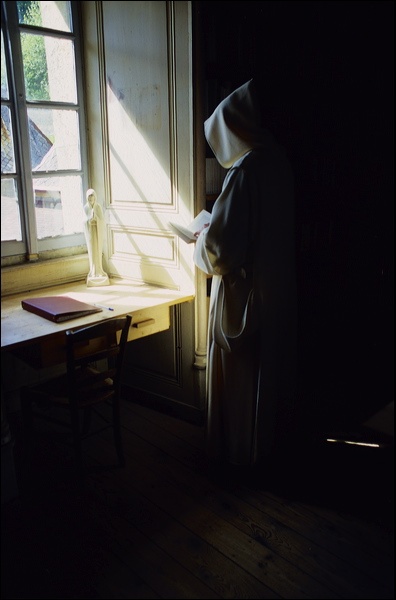1. The spiritual journey of Saint Bruno is
characterized by the search for God in
solitude, this God he knows
to be intimately present in his heart. It would be
desirable that the members of the CLC consecrate every
day, according to their possibilities, a few moments to silence for: prayer
of the heart, meditation or reading.
2. CLC
officials will provide, at the disposal of their members,
a few essential elements to help in the development of this prayer (texts, life of St. Bruno, order history,
excerpts of the Statutes of the Order).
3. It is
important to encourage a regular sacramental
practice, depending on the
possibilities of each one (the Eucharist and
confession), as well as to make
an annual retreat to
better be impregnated of silence and solitude.
4. Contacts between members are to be encouraged,
indirectly through the internet forum, but also through small groups when this is possible. Leaders will
organize these internet contacts within a frequency which
can vary between two and four weeks (video conferencing?).
It is advisable to set themes and 'helm' the exchanges.
5. An executive board consisting of
about seven members (including a priest and at least two
women) is to be to put in place, who jointly
decides which path to follow.
6. This executive
board also prepares the creation of a private association
of the faithful. To properly set everything up, one must
take time and hasten nothing.
7. Serious
discernment, if not severe, must be put in place for the
admission of members into the second degree. They must
clearly know what they undertake and what are their
obligations (see 1.2.3.)
8. Regular contact with the
hierarchy of the Church (the best is a bishop) is to be
sought and maintained.
9. The forum, which
is not an end in itself, but a means to help some people
develop their spiritual life, in the example and with the
help of Saint Bruno, must be cleansed:
a.
Avoid unnecessary chatter and discussions that are
far from the aim of the CLC.
b. The ecumenical
openness must be conducted according to the norms
of the Church and you will exclude
any tendency to religious syncretism.
c. You also avoid
to compromise with pressure groups of ideas either
integrist or avant-gardist. To
the spiritual path in accordance with Saint Bruno, is appropriate
great sobriety and modesty, remote from any controversy.
d. We progress, all
together, in the respect
of the Magisterium of the Church.
e. The role of the
moderators is very important; they must work and intervene
according to clearly defined rules.
10. The name of the CLC: it would be
desirable to make an explicit reference to Saint Bruno,
rather than to the Carthusian Order. "International
Fellowship of Saint Bruno" is good; otherwise "Saint Bruno
Lay Contemplatives".
11. To obtain an official support from the
Order, the time is still premature. It becomes possible only
after the establishment of the association and to the extent
where this one, in its organization and practice, truly
reflect the spirit of Saint Bruno, in an
adaptation to the condition of laity living in the open
world. This may take several
years, which is not at all serious, since we are working on
the long term.
 We would strive to convert our life, as laity living in the open world,
within our duty of state, to the point where it is simple
and perfectly balanced for us to live in the spirit
of continual prayer of Saint Bruno (and the Carthusian
Order). This is an internal endeavor, which will be developed and favored by our
discerned, elective,
discrete and eventually shared, personal, external lay
monastic adapted practices or customs.
We would strive to convert our life, as laity living in the open world,
within our duty of state, to the point where it is simple
and perfectly balanced for us to live in the spirit
of continual prayer of Saint Bruno (and the Carthusian
Order). This is an internal endeavor, which will be developed and favored by our
discerned, elective,
discrete and eventually shared, personal, external lay
monastic adapted practices or customs.